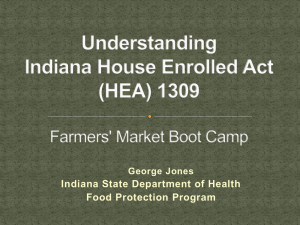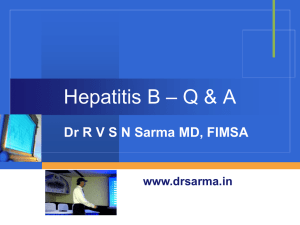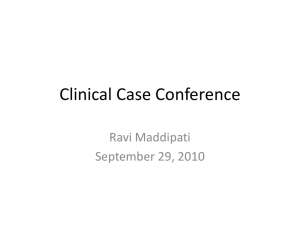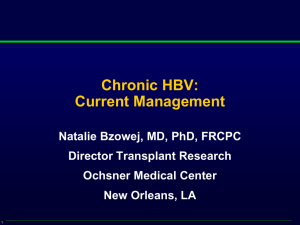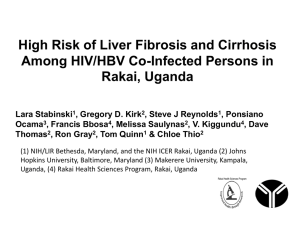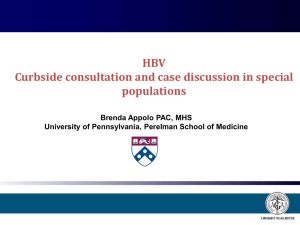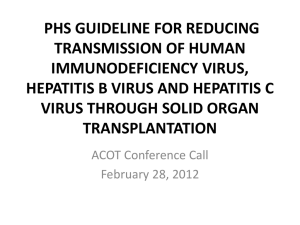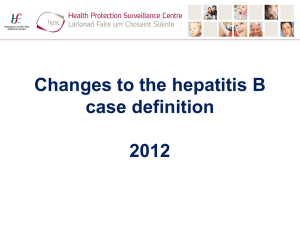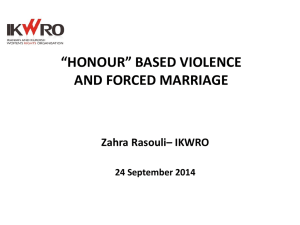HBV - ncsgna
advertisement
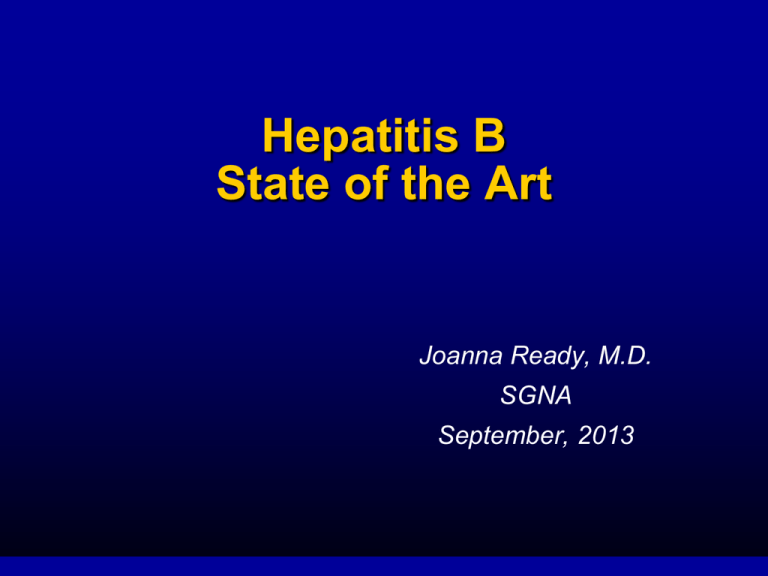
Hepatitis B State of the Art Joanna Ready, M.D. SGNA September, 2013 Magnitude of HBV Infection(s) • World wide: 2 billion persons infected — 350 million cases of chronic HBV — 15-40% progress to cirrhosis/HCC • US: 1.25 million persons with chronic HBV — In Asian Americans: 7-16% carrier rate HBV is a life long, dynamic disease • Changes over time • Risk of end stage liver disease and cancer increases with ongoing inflammation and viremia in adults • Fibrosis can be reversible • Drugs can decrease fibrosis progression • HBV can be controlled but not cured • Reactivation can occur even in those who have lost HBsAg Slide 3 Who should be tested for HBV? • • • • • Blood and organs donors Hemodialysis patients Pregnant women Infants of HBsAg + mothers Behavioural contacts: — Household and sexual contacts — HIV+, MSM, IDU • Individuals from countries where prevalence is ≥2% • Patients receiving immunosuppressive therapy • Abnormal ALT of unknown cause CDC 2008 Slide 4 Geographic Distribution of Chronic HBV Infection Country HBsAg+ (%) China 5.3-122 South Korea 2.6-5.12 India 2.4-4.72 Taiwan 10-13.82 Vietnam 5.7-102 Japan 4.4-133 Africa 5-192 Russia 1.4-82 US/Europe 0.3-122 HBsAg 8: 2–8: <2: Prevalence (%)1 High Intermediate Low 1. WHO. Hepatitis B. 2002. 2. Custer B, et al. J Clin Gastroenterol. 2004;38(10 suppl):S158. 3. WHO/WPRO data. Slide 5 Geographic Distribution of HBV Genotypes Greenland: A, B, D Ae, Bj, C, D, F B, A/Bj Ae B,C,A,D D C G G A D D FF1&, H H H F2 E Bj Ba B B3 Aa BC D Slide 6 Why is Genotype Important? • Risk of cirrhosis — B/C: highest risk of cirrhosis (B<C) — D: also high risk • Risk of Heptocellular carcinoma — B/C: highest risk of HCC — B: HCC at younger age; absence of cirrhosis • Response to treatment — A: most responsive to IFN Slide 7 How to test for HBV? • HBsAg • Anti-HBs • Anti-HBc Slide 8 What to do with results? HBsAg HBsAb HBcAb • + - + refer to care • - + + past infection • - - - vaccinate • - + - vaccinated Slide 9 Hepatitis B Vaccine • Vaccine licensed in 1982 — Plasma-derived recombinant vaccine — 3-dose series, high efficacy, no boosters, safe • Since licensing, adolescents and adults at high risk recommended to receive vaccine • Comprehensive strategy to eliminate HBV transmission implemented in 1991 — 1991: universal infant vaccination recommended — 1995: expansion to include vaccination of all adolescents ages 11-12 yrs — 1998: vaccination of all persons age 0-18 yrs not previously vaccinated Slide 10 Achievements With HBV Vaccination • Decline in acute HBV in past decade by 67% — Reflects effects of routine infant and childhood vaccination • Vaccination rates high in this population but decline to ~ 60% in adolescents — Slowest rate of decline in adults • Some adult subgroups showing increase in incidence (men ≥ 19 yrs, women ≥ 40 yrs) • Decline in risk of serious complications of chronic HBV — Reduced rates of childhood HCC in countries of high endemnicity Centers for Disease Control and Prevention (CDC). MMWR Morb Mortal Wkly Rep. 2004;52:1252-1254. Slide 11 The phases of chronic hepatitis B Immune tolerance Immune clearance HBeAg+ve < Immune control Immune escape HBeAg–ve >< > HBV-DNA ALT HBeAg +ve chronic hepatitis Inactive (carrier) state* *Previously considered to be ‘healthy carriers’ HBeAg –ve active chronic hepatitis Slide 12 HBV Control the goal • Inflammatory: normalize serum ALT, biopsy • Virologic: decrease HBV DNA • Immune: seroconversion — HBeAg to HBeAb — HBsAg to HBsAb • HBV never “cured” but controlled Slide 13 Who should be considered for treatment? Immune tolerance Immune clearance HBeAg+ve < Immune control >< Immune escape HBeAg–ve > HBV-DNA ALT treat treat HBeAg +ve chronic hepatitis Inactive (carrier) state HBeAg –ve/+ve active chronic hepatitis Slide 14 Overview of Algorithm Used to Determine Need for Treatment of HBV HBeAg Positive HBV DNA >20,000 IU/mL HBeAg Negative HBV DNA >2,000 IU/mL ALT Level Elevated ALT Normal ALT Monitor ALT Q3mos for 1y Treat Consider Liver Biopsy If >40yrs Significant fibrosis or inflammation Lok AS et al Hepatology, 2009 Slide 15 Approved HBV treatments 2013 • Interferon alfa-2b – 1991 • Lamivudine – 1998 • Adefovir – 2002 • Entecavir – 2005 • Peginterferon alfa-2a – 2005 • Telbivudine – 2006 • Tenofovir - 2008 For HIV: — Emtricitabine — Tenofovir + emtricitabine (single pill co-formulation) Slide 16 Therapeutic endpoints over time Improved Improved Anti-HBs+ survival histology Loss of Anti-HBe+ HBsAg Loss of HBeAg Loss of HBV DNA TIME Slide 17 Treatment Goals in CHB: Remission Differences between the two strategies On-therapy Off-therapy sustained maintained response response = Low viremia = Low viremia ALT normalization ALT normalization Continued need for Immune control, antiviral drugs no antiviral drugs Slide 18 HBV Nucs: Nonresponse, Suboptimal Response, and Virologic Breakthrough Change in HBV DNA (log10 IU/mL) 1.0 Antiviral Drug Primary nonresponse 0 Virologic breakthrough -1.0 Suboptimal response -2.0 -3.0 Nadir -4.0 0 6 1 log 12 18 Months Lok AS, et al. Hepatology. 2007;45:507-539. Slide 19 HBeAg Seroconversion Rates Over Time in HBeAg-Positive Patients HBeAg Seroconversion (%) Not head-to-head trials; different patient populations and trial designs 100 Extended Treatment With Nucleos(t)ide Analogues* vs Limited Duration (1 Yr) Peginterferon Treatment 80 Entecavir Tenofovir Peginterferon 60 39 40 20 31 21 22 22-27 26 29-32 35 26 0 1.0 Yr 1.5-2.0 Yrs 3.0-4.0 Yrs *With sustained undetectable HBV DNA. Chang TT, et al. J Viral Hepat. 2009;16:784-789. Chang TT, et al. AASLD 2006. Abstract 109. Lau GK, et al. N Engl J Med. 2005;352:2682-2695. Marcellin P, et al. N Engl J Med. 2008;359:2442-2455. Buster EH, et al. Gastroenterology. 2008;135;459-467. Heathcote J, et al. AASLD 2008. Abstract 158. Heathcote J, et al. AASLD 2009. Abstract 483. Janssen HL, et al. Lancet. 2005;365;123-129. Slide 20 HBsAg Loss Over Time in HBeAgPositive Patients Not head-to-head trials; different patient populations and trial designs HBsAg Loss (%) 100 Extended Treatment With Nucleos(t)ide Analogues* vs 1 Yr Peginterferon Treatment 80 Entecavir Tenofovir Peginterferon 60 40 20 2 3 5 5 6 0 1.0 Yr 8 6 1.5-2.0 Yrs 8 NA 3.0-4.0 Yrs *With sustained undetectable HBV DNA. Chang TT, et al. N Engl J Med. 2006;354:1001-1010. Marcellin P, et al. N Engl J Med. 2008;359:2442-2455. Buster EH, et al. Gastroenterology. 2008;135;459-467. Gish R, et al. Gastroenterology. 2007;133:1437-1444. Heathcote J. AASLD 2008. Abstract 158. Heathcote J, et al. AASLD 2009. Abstract 483. Janssen HL, et al. Lancet. 2005;365:123-129. Slide 21 Undetectable HBV DNA Over Time in HBeAg-Negative Patients Not head-to-head trials; different patient populations and trial designs Undetectable HBV DNA (%) Extended Treatment With Nucleos(t)ide Analogues vs 1 Yr Peginterferon Treatment 100 90 96 93 80 100* 91 87 Entecavir Tenofovir Peginterferon 63 60 40 20 15 NA 0 *Single center study. 16 1 Yr 2 Yrs 3 Yrs Lok AS, et al. Hepatology. 2009;50:661-662. Marcellin P, et al. AASLD 2008. Abstract 146. Marcellin P, et al. AASLD 2009. Abstract 481. Marcellin P, et al. Gastroenterology. 2009;136:2169-2179. Baqai S, et al. AASLD 2009. Abstract 476. Lai CL, et al. Hong Kong International Liver Congress 2006. Slide 22 HBsAg Loss Over Time in HBeAg-Negative Patients Not head-to-head trials; different patient populations and trial designs 100 Extended Treatment With Nucleos(t)ide Analogues* Vs 1 Yr Peginterferon Treatment Patients (%) 80 Entecavir Tenofovir Peginterferon 60 40 20 0 <1 0 4 1.0 Yr <1 0 9 7 1.5-2.0 Yrs NA 0 3.0-4.0 Yrs *With sustained undetectable HBV DNA. Lai CL, et al. N Engl J Med. 2006;354:1011-1020. Marcellin P, et al. N Engl J Med. 2008;359:2442-2455. Marcellin P, et al. AASLD 2008. Abstract 146. Shouval D, et al. J Hepatol. 2009;50:289-295. Marcellin P, et al. AASLD 2009. Abstract 481. Brunetto M, et al. EASL 2008. Abstract 683. Slide 23 Duration of nucleoside analogue treatment in Chronic HBV • HBeAg-positive: until HBeAg seroconversion to anti-HBe and consolidation 6-12 mos (80% durable) • HBeAg-negative: until HBsAg clearance — Normal ALT and HBV DNA low in 65-70% at 5 years — ADV d/c Rx 5y: 18/33 inactive and 13/18 cleared HBsAg — IFN f/u 5y 230 pts: 12% lost HBsAg • Compensated cirrhosis: long-term treatment unless confirmed HBsAg clearance • Close monitoring for viral relapse and hepatitis flare is mandatory if treatment is stopped • Decompensated cirrhosis and post-liver transplantation: life-long treatment Lok AASLD 2009; Hadziyannis Gastro 2012 Slide 24 Selection of Entecavir vs Tenofovir 21 21 Response at Wk 48-52 (%) Tenofovir • HBeAg pos 6.9 6.2 • HBeAg neg 5.0 4.6 • NA naive 1.2 (Yr 5) 0 (Yr 3) • Lamivudine experienced 51 (Yr 5) NR Pregnancy rating Class C Class B None Renal toxicity; ↓ BMD Log HBV DNA ↓ at Wk 48-52 25 20 Entecavir Tenofovir 15 10 5 2 0 Entecavir HBeAg seroconversion 3 <1 0 HBsAg loss HBeAg Positive HBsAg loss Genotypic resistance, % AEs HBeAg Neg Lok AS. Hepatology. 2010;52:743-747. Slide 25 HBV Therapy and Chronic renal disease • All nucleos(t)ide analogues must be dosed according to GFR in patients with chronic kidney disease (CKD) • TDF can cause renal disease — TDF filtered by glomerulus — Toxicities reported: • Acute tubular necrosis • Fanconi’s – Proteinuria/glucosuria/phophoturia/hypokalemic RTA/bone loss • Diabetes insipidus (rare) Slide 26 Tenofovir Nephrotoxicity • Exposure in 10,841 HIV+ VA pts on ART from 1997– 2007 — Events: 3400 proteinuria, 3078 GFR (>3ml/min/y) and 533 CKD (<60 ml/min) — De novo appearance of 3 of 5 of proteinuria, glucosuria, hypophosphatemia, hypouricemia, Cr. • 51 HBV patients followed for mean 6.4y • 7/51 had renal tubular dysfunction — Associated with older patients, lower baseline GFR — Improved with switch to ETV Scherzer and Shlipak AIDS 2012; Gara and Hoofnagle AASLD 2011 Slide 27 Efficacy of Entecavir vs Tenofovir in the Setting of Resistance • Similar antiviral activity against nonresistant HBV; efficacy against drug-resistant strains differs Activity According to Resistance LAM/LdT resistance ETV resistance ADV resistance TDF resistance Entecavir Tenofovir Decreased Active -Active Active Decreased Active -- Lok AS. Hepatology. 2010;52:743-747. Slide 28 Potency of HBV DNA suppression NAs: Potency versus resistance Nucleoside analogue Nucleotide analogue TDF ETV LdT LAM ADV Likelihood of resistance development Slide 29 Antiviral resistance increases over time 80 Incidence of resistance (%) Lamivudine1 70% 65% Adefovir2 60 Entecavir (LAM-resistant)3 53% Entecavir (naive)3 *** Telbivudine4 40 42% 40% 29% 25% 24% 20% 20 18% 15% 12% 11% 5% 0 0.1% 0% Year 1 0.3% 2% Year 2 0.4% 0.8% Year 3 Year 4 Year 5 Resistance to NAs…is it just a matter of time?? 1 Lai, Clin Infect Dis 2003; 2 Westland, Hepatology 2003; 3 Colonno R, EASL 2007; 4 Gane, EASLSlide 2006 30 Special Populations with HBV • Cirrhosis • Decompensated cirrhosis • Organ transplantation • Acute hepatitis B • Pregnancy • Co infection with HCV or HDV • Chronic renal failure • Children Slide 31 Cirrhosis • 5 y Survival 84% for compensated • 5 y Survival 14-35% for decompensated6 • Interferons are safe and effective in compensated HBV cirrhosis only1 • Nucleoside analogues have been shown prospectively to be safe, decrease rates of liver decompensation and to decrease the development of HCC2 • All cirrhotic patients with HBV DNA>2000 IU/mL should be treated regardless of ALT3-5 • Many experts recommend treating compensated cirrhotics with any detectable viral load3 1Buster, 2007; 2Liaw, 2004; 3Keeffe, 2008; 4Liaw 2008 (APASL); 5Lok 2007; 6Kim 2004 Slide 32 Treatment decreases HBV disease progression even with YMDD mutant status Patients with disease progression (%) 25 Placebo (n=215) YMDD mutants (n=209) (49%) Wild-type (n=221) 20 21% 15 13% 10 5% 5 0 0 6 12 18 24 30 36 Time after randomisation (months) Liaw et al. N Engl J Med 2004 Slide 33 Lamivudine in Decompensated Cirrhosis 23 consecutive UCSF patients compared with 23 historical controls Survival (%) 100 80 Lamivudine treated 60 P < .001 40 Controls 20 0 0 6 12 18 24 30 Time (mo) 36 42 48 Cumulative probability of survival without liver transplantation Yao FY, et al. Hepatology. 2001;34:411. Slide 34 Liver Transplantation and HBV Progress in Past Decade HBIG LAM Era 1 (1987-1991) 1 0.9 0.9 0.8 0.8 P < 0.01 Survival % Survival % Era 3 (1997-2002) 1 Other 0.7 HBV 0.6 0.5 0 1 2 3 Time (years) 4 5 • 5-year survival rates ~50% • Many centers consider HBV to be contraindication for LT HBV 0.7 P = .14 Other 0.6 0.5 0 1 2 3 Time (years) 4 5 • 5-year survival rates as good or better than for other indications for LT Kim WR, et al. Liver Transpl. 2004;10:968. Slide 35 Pregnancy and Hepatitis B • Vertical transmission remains the most frequent route of infection worldwide — Endemic areas: • 20% women of childbearing age infected with HBV • Perinatal acquisition: 90% rate of chronicity – In contrast to: » Acquisition age 1-5: 20-30% chance of chronic infection » Acquisition as adult: < 5% chance of chronic infection • Risk of infection to the infant: — HBeAg + status of the mother — Viral load of the mother • >106 copies/mL; 200,000IU/ml Slide 36 Pregnancy (cont) • HBIg and HBV vaccination — HBIg within 12 hrs of birth & HBV vaccination series by month six: • Beasley et (1981): reduction of HBV transmission from 90% to 26% with HBIg • Follow up studies using active and passive immunization: 3-7% rate of transmission to the infant • Failures: eAg positive mothers with high viral loads • Data on the Rx of HBV during pregnancy remains limited: Category B Category C telbivudine lamivudine tenofovir entecavir emtricitabine adefovir Slide 37 Pregnancy (cont) • All current drugs have the potential for mitochondrial toxicity lactic acidosis syndrome; deleterious effects on organogenesis; no study has reported longterm effects (i.e. after one year) • Safety data: — Antiretroviral Pregnancy Registry (APR) & the Development of Antiretroviral Therapy Study (DART): • 112 mono-infected patients Rx with antiretrovirals: – 2.7% birth defects (APR); 3% (DART) – 2.4% in all births reported by CDC Slide 38 Pregnancy (cont) • Lamivudine most extensively studied agent — Suu et al (2003): • 38 women who became pregnant on lamivudine – None of the infants positive at 1 year – 26% of historical controls — von Zonneveld et al (2003): • 8 women eAg + with DNA >1.2 X 109 during the last 4 weeks of pregnancy – 1 of 8 infants sAg positive at 1 year (12.5%) vs 28% of historical controls — Xu et al (2009): • Double-blind, placebo-controlled trial of lamivudine and immunoprophylaxis during the last 8 weeks of pregnancy vs HBIg and HBV vaccination alone – – – – – 151 women 18% of babies in arm A were sAg positive at 1 year 39% of babies in arm B were sAg positive at 1 year In large part due to a significant number of mothers/infants lost to follow-up For those with complete data: » At 1 year: 13% positive in arm A 31% in arm B no significant difference • No study has reported increased adverse fetal events with lamivudine Slide 39 Pregnancy (cont) • Tenofovir — Class B drug — High genetic barrier to resistance — No increased adverse fetal events • Telbivudine — Similar results — Low genetic barrier to resistance • No published studies using entecavir, adefovir, emtricitabine to prevent vertical transmission • Current CDC/AASLD guidelines have not made specific recommendations regarding the treatment of pregnant women with HBV Slide 40 Pregnancy (cont) • Effect on successful delivery — Theoretical but not proven: • Increased bleeding/abruption • Gestational diabetes • LBW • Pregnancy’s effect on HBV — Rare, usually eAg + mothers • Effect of Rx on mother’s disease: — No change in disease progression — Stopping Rx after delivery: • ALT flare 12-25%; rarely clinically significant; responds to reinstitution of Rx – 12-17% of women will have a mild flare after deliver without withdrawal of drugs Slide 41 Pregnancy (cont) • When to begin treatment? — No data available • First/second trimester if mother has evidence of significant liver impairment/ongoing damage – High ALT and VL – Evidence of fibrosis low platelet count; radiographic evidence • Check VL at the end of the second trimester consider Rx for VL>106 (200,000IU/ml) OR history of prior children with chronic hepatitis B, regardless of the VL • When to end treatment? — Again, no data available — Consider if in immunotolerant phase — Risk hepatic decompensation Slide 42 Slide 43 Slide 44 Reactivation of HBV • High rate of reactivation in immunosuppressed patients — Chemotherapy — HIV after immune reconstitution — Post organ transplant — Biologic response modifiers: rituximab (antiCD20), TNF- inhibitors: GI, hematologists, rheumatologists, dermatologists • Reactivation can occur in immunocompetent treated with steroids, BRMs Slide 45 Reactivation of HBV • Highest in HBV active disease — HBsAg and HBeAg pos, high HBV DNA — HBsAg and HBeAb pos, low HBV DNA — HBsAg neg, anti-HBs neg, anti-HBc pos • “occult HBV” — Deaths occur in all groups • ALL patients undergoing chemotherapy must have tested HBsAg, HBsAb and HBcAb prior to treatment Slide 46 Screening for Liver Cancer: Lack of Consensus • Optimal age for initiation of screening unknown1 — Patients ≥ 35 yrs are at much higher risk for HCC than those < 35 years2 — Asian males aged 40; females aged 50 — Sub-Saharan Africans > 20 — Cirrhosis, any age — Co-infection with HCV/HIV Current AASLD guidelines — ? ETOH • Among HBV-infected individuals, HCC can occur at any age, including childhood (genotype B?) • Up to 1/3 of patients with HCC have normal AFP • AFP may be elevated in 1/3 of patients with cirrhosis without HCC 1. Lok AS, and McMahon BJ. Hepatology. 2001; 34:1225-1241. 2. Liaw YF, et al. Gastroenterology. 1986;90:263-267. Slide 47 HBV is a dynamic disease • Diagnose • Initial evaluation includes education — Family and sexual contacts should be tested — counsel drugs to avoid- steroids, chemo, BRM • Monitor as status changes over time — ALT /HBV DNA may not remain normal over time especially in anti-HBe • • Selection who to treat • Individualize treatment decisions • Change if no/ poor response Long term monitoring HCC, reactivation Slide 48 HBV: The importance of monitoring HBV is a dynamic disease!!! Require treatment 60% 40% Require monitoring… • Inactive disease may not remain inactive • Liver damage may occur if HBV reactivates HBV can be controlled but not cured Slide 49 Serology of HBV (addendum) Infection ALT HBeAG AntiHBV DNA HBeAb IU.ml histology Immune tolerant nl Pos+ Neg- High normal Chronic hepatitis HBeAg + up Pos+ Neg- >20,000 Active Inactive carrier nl Neg- Pos+ <2,000 normal Chronic hepatitis HBeAg- up Neg- Pos+ >2,000 active Slide 50


